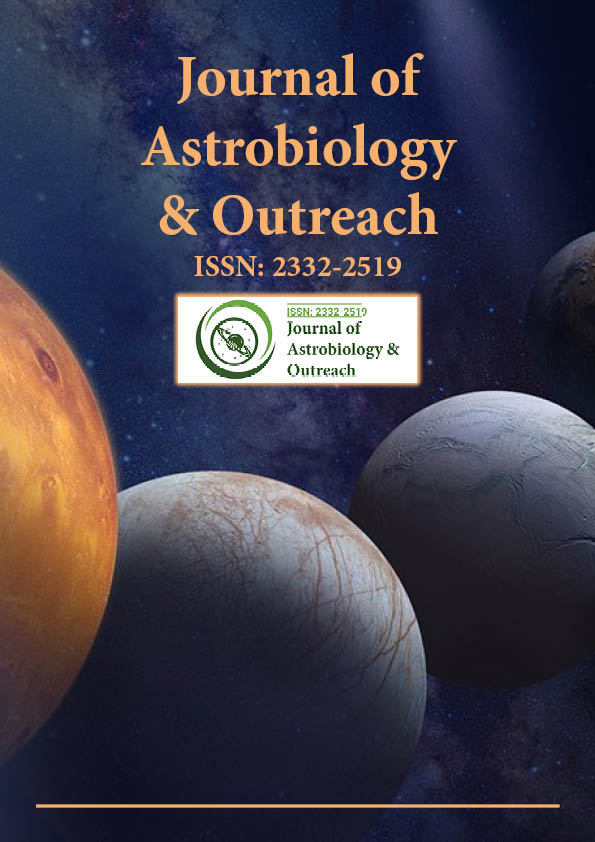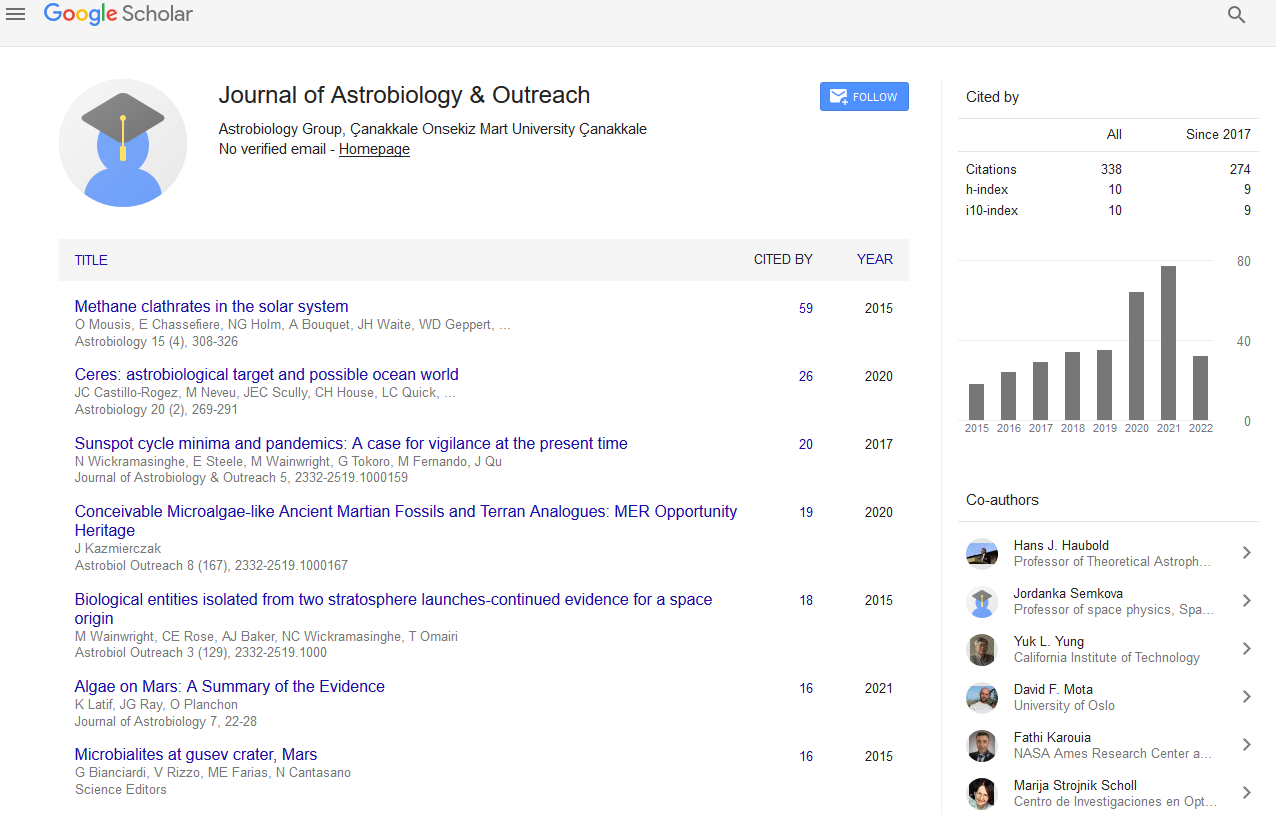Indexed In
- Open J Gate
- Academic Keys
- JournalTOCs
- RefSeek
- Hamdard University
- EBSCO A-Z
- OCLC- WorldCat
- Google Scholar
Useful Links
Share This Page
Journal Flyer

Open Access Journals
- Agri and Aquaculture
- Biochemistry
- Bioinformatics & Systems Biology
- Business & Management
- Chemistry
- Clinical Sciences
- Engineering
- Food & Nutrition
- General Science
- Genetics & Molecular Biology
- Immunology & Microbiology
- Medical Sciences
- Neuroscience & Psychology
- Nursing & Health Care
- Pharmaceutical Sciences
Commentary - (2025) Volume 13, Issue 1
Biosignature Preservation in Simulated Martian Environments
Mia Altair*Received: 19-Feb-2025, Manuscript No. JAO-25-28774; Editor assigned: 21-Feb-2025, Pre QC No. JAO-25-28774 (PQ); Reviewed: 07-Mar-2025, QC No. JAO-25-28774; Revised: 14-Mar-2025, Manuscript No. JAO-25-28774 (R); Published: 21-Mar-2025, DOI: 10.35248/2332-2519.25.13.375
Description
The search for life beyond Earth, particularly on Mars, remains one of the most compelling searches in planetary science. With the current generation of robotic missions delving deeper into the planet's geology and chemistry, experimental simulations on Earth are critical to identifying potential biosignatures. A central issue in these investigations is whether biosignatures behave differently in open versus closed systems scenarios that replicate the diversity of Martian environments, from exposed regolith to subsurface niches.
Open systems on Mars, such as the planet’s oxidizing surface environment, are continuously influenced by ultraviolet radiation, temperature fluctuations and interactions with atmospheric gases like CO2 and perchlorates. These dynamic interactions can degrade organic molecules and destroy or obscure potential biosignatures. In experimental settings, simulating such open systems enables researchers to assess the survivability and detectability of biological compounds under Martian surface-like conditions. These simulations have shown that amino acids, lipids and microbial cells degrade quickly when exposed to UV light and reactive soil chemistry. Thus, any biosignatures preserved in open systems are likely to be fragmented, chemically altered, or present in trace amounts challenging the sensitivity and specificity of current analytical tools aboard Mars rovers.
In contrast, closed systems simulate protected environments, such as subsurface rock pores, ice-covered brines, or sediment-filled cavities that may be shielded from surface radiation and oxidation. These settings are believed to offer a more stable environment for the long-term preservation of biosignatures. Experimental studies replicating these closed systems often incorporate shielding by mineral matrices, low temperatures and anoxic conditions parameters that can significantly extend the preservation of biomolecules. In such conditions, lipids, nucleic acid fragments and isotopic signals are far more resilient and fossil-like microbial morphologies can persist for geologic timescales. These findings are promising, suggesting that Martian life if it ever existed would more likely be detectable in sheltered environments.
A notable strength of these experimental approaches is their ability to test detection instruments in realistic Mars-like settings. For example, laboratory simulations that expose biosignature-bearing samples to radiation or embed them within Mars-analog minerals (such as jarosite or silica) can validate the performance of spectrometers, chromatographs and imaging tools planned for Mars missions. By doing so, researchers can refine sampling protocols and increase the confidence level in biosignature interpretation once data is returned from Mars.
However, experimental simulations must also contend with the complexity and diversity of possible Martian biosignatures. There remains a fundamental uncertainty in assuming that Martian life if it evolved independently would leave behind the same molecular footprints as Earth-based organisms. While comparative planetary biology can justify the focus on universal biosignatures like carbon isotopic ratios, lipid bilayers, or certain chirality patterns, these assumptions must be tempered with caution. Studies in both open and closed systems have demonstrated that some biosignature analogs can be produced abiotically, complicating the differentiation between biotic and non-biotic origins.
Another emerging consideration is the interplay between mineralogy and biosignature preservation. Experimental findings suggest that certain minerals, such as clays or sulfates, can either protect or catalyze the degradation of organic matter. In open systems, minerals may act as UV shields or reactive surfaces, while in closed systems, they may participate in redox reactions that either fix or alter biosignatures. Understanding these nuanced interactions is essential for correctly interpreting future detections.
Despite challenges, experimental studies comparing open and closed systems have already had significant implications. For example, the Mars 2020 Perseverance rover was strategically equipped with coring tools to access subsurface samples and maximizes the likelihood of biosignature preservation. Likewise, the upcoming ESA Rosalind Franklin rover plans to drill two meters beneath the surface, directly informed by experimental insights showing that deeper layers are more likely to preserve organics. These missions increasingly rely on Earth-based simulations to optimize target selection and detection strategies.
In conclusion, the experimental identification of potential Martian biosignatures in both open and closed systems has provided critical guidance for planetary exploration. The contrast between the degradative nature of open systems and the preservative potential of closed systems highlights the importance of accessing protected environments on Mars. Continued refinement of simulation techniques and a deeper understanding of bio-mineral interactions will improve our ability to recognize true signs of life and avoid false positives. As humanity stands on the brink of potentially transformative discoveries, these experimental insights will remain at the heart of interpreting Mars’s secrets.
Citation: Altair M (2025). Biosignature Preservation in Simulated Martian Environments. J Astrobiol Outreach. 13:375.
Copyright: © 2025 Altair M. This is an open-access article distributed under the terms of the Creative Commons Attribution License, which permits unrestricted use, distribution, and reproduction in any medium, provided the original author and source are credited.

